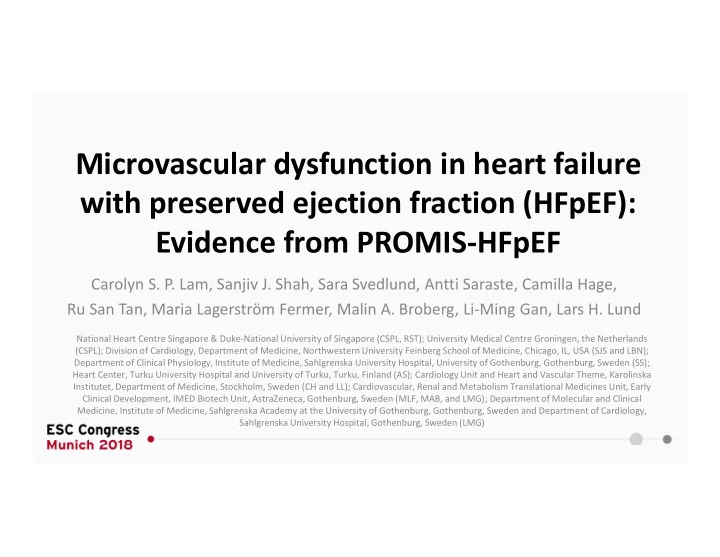

Microvascular dysfunction in heart failure with preserved ejection fraction (HFpEF): Evidence from PROMIS-HFpEF Carolyn S. P. Lam, Sanjiv J. Shah, Sara Svedlund, Antti Saraste, Camilla Hage, Ru San Tan, Maria Lagerström Fermer, Malin A. Broberg, Li-Ming Gan, Lars H. Lund National Heart Centre Singapore & Duke-National University of Singapore (CSPL, RST); University Medical Centre Groningen, the Netherlands (CSPL); Division of Cardiology, Department of Medicine, Northwestern University Feinberg School of Medicine, Chicago, IL, USA (SJS and LBN); Department of Clinical Physiology, Institute of Medicine, Sahlgrenska University Hospital, University of Gothenburg, Gothenburg, Sweden (SS); Heart Center, Turku University Hospital and University of Turku, Turku, Finland (AS); Cardiology Unit and Heart and Vascular Theme, Karolinska Institutet, Department of Medicine, Stockholm, Sweden (CH and LL); Cardiovascular, Renal and Metabolism Translational Medicines Unit, Early Clinical Development, IMED Biotech Unit, AstraZeneca, Gothenburg, Sweden (MLF, MAB, and LMG); Department of Molecular and Clinical Medicine, Institute of Medicine, Sahlgrenska Academy at the University of Gothenburg, Gothenburg, Sweden and Department of Cardiology, Sahlgrenska University Hospital, Gothenburg, Sweden (LMG)
Disclosures • Supported by a Clinician Scientist Award from the National Medical Research Council of Singapore • Received research support from Boston Scientific, Bayer, Roche Diagnostics, Medtronic, and Vifor Pharma • Consulted for Astra Zeneca, Bayer, Novartis, Amgen, Merck, Janssen Research & Development LLC, Menarini, Boehringer Ingelheim, Abbott Diagnostics, Corvia, Stealth BioTherapeutics, and Takeda • PROMIS-HFpEF is an AstraZeneca initiated and sponsored study
Background • No treatment yet shown to reduce morbidity and mortality in HFpEF 1 • Coronary microvascular dysfunction (CMD) proposed as a novel mechanism in HFpEF 2-5 • Clinical evidence of CMD in HFpEF limited to selected referral samples 6-10 1 Eur Heart J 2016;37:2129, 2 J Am Coll Cardiol 2013;62:263, 3 JACC Heart Fail 2016;4:312, 4 Heart 2016;102:257, 5 Eur Heart J 2018 doi: 10.1093/eurheartj/ehy301, 6 Microcirculation 2015;22:528, 7 Eur Heart J 2018;39:840, 8 Am J Physiol Heart Circ Physiol 2018;314:H1033, 9 JAHA 2016;5.pii: e002649, 10 Circ HF 2016;9.pii: e002562
Aims Prospective multicenter PRevalence Of Microvascular dySfunction in HFpEF (PROMIS-HFpEF) study • To investigate the prevalence of CMD and its association with systemic endothelial dysfunction, HF severity, and myocardial dysfunction in a well- defined, prospective HFpEF population using a comprehensive functional imaging approach
Methods • Prospective patients with confirmed chronic HFpEF from Sweden, US, Finland and Singapore • Major inclusion criteria: – Signs & symptoms of HF; stable NYHA II-IV – EF ≥ 40% – At least one of (1) ↑natriure�c pep�des; 1 (2) HF hospitalization in last 12 months with LVH/LAE; (3) PCWP >15 mmHg (rest) or >25 mmHg (exercise);or (4) E/e’ > 15 • Major exclusion criteria: – Significant unrevascularized epicardial CAD – Primary cardiomyopathy – Hemodynamically significant valve disease – Any history of EF<40% 1 In the last 1 year: Outpatient NTproBNP ≥ 300 ng/L or BNP ≥ 75 ng/L with sinus rhythm; NTproBNP ≥ 750 ng/L or BNP ≥ 200 ng/L with AF; Acute Inpatient NTproBNP ≥ 500 ng/L or BNP ≥ 125 ng/L with sinus rhythm, NT-proBNP ≥1250 ng/L or BNP ≥ 350 ng/L with AF
Methods • Coronary flow reserve (CFR) by transthoracic Doppler echo coronary flow velocity at rest and with adenosine – Read by core lab – CMD defined as CFR<2.5 • Systemic microvascular function by peripheral arterial tonometry (EndoPAT) reactive hyperemia index (RHI) • Myocardial function by echo tissue Doppler and speckle-tracking
Results Prevalence of CMD among 202 HFpEF with CFR = 75% (95% CI 69-81%) • Mean (SD) CFR = 2.13 (0.51) • Median (IQR) CFR = 2.08 (1.78-2.50) CFR attempted in 233;successful in 87%
Results Characteristic CMD absent CMD present P-value (N=51) (N=151) 72.4 ± 9.0 74.7 ± 8.7 Age, years 0.11 Female, n(%) 32(63) 79(52) 0.20 Comorbidities, n(%) Hypertension 47(92) 123(81) 0.07 Previously revascularized CAD 8(16) 31(21) 0.45 Atrial fibrillation 18(35) 88(58) 0.004 Diabetes 13(25) 45(30) 0.56 Obesity 22(43) 49(32) 0.17 Chronic kidney disease 25(49) 80(53) 0.63 Current or prior cigarette smoker 22(43) 106(70) <0.001
Characteristic CMD absent CMD present P-value 63 ± 20 59 ± 19 eGFR, mL/min/1.73 m 2 0.16 UACR, mg/g 2.4 (1.1-3.7) 4.3 (1.4-18.8) 0.036 NT-proBNP, pg/mL 597 (190-1410) 1050 (396-1930) 0.004 Doppler echo 102.1 ± 26.1 110.3 ± 36.6 LV mass index, g/m 2 0.14 12.4 ± 4.7 13.5 ± 6.2 LV E/e’ ratio 0.24 4.7 ± 0.6 4.9 ± 0.7 RV wall thickness, cm 0.016 19.7 ± 3.6 17.5 ± 3.7 TAPSE, mm <0.001 40.5 ± 10.8 45.6 ± 15.3 PASP, mmHg 0.05
Characteristic CMD absent CMD present P-value 63 ± 20 59 ± 19 eGFR, mL/min/1.73 m 2 0.16 UACR, mg/g 2.4 (1.1-3.7) 4.3 (1.4-18.8) 0.036 NTproBNP, pg/mL 597 (190-1410) 1050 (396-1930) 0.004 Doppler echo 102.1 ± 26.1 110.3 ± 36.6 LV mass index, g/m 2 0.14 12.4 ± 4.7 13.5 ± 6.2 LV E/e’ ratio 0.24 4.7 ± 0.6 4.9 ± 0.7 RV wall thickness, cm 0.016 19.7 ± 3.6 17.5 ± 3.7 TAPSE, mm <0.001 40.5 ± 10.8 45.6 ± 15.3 PASP, mmHg 0.05 Speckle-tracking echocardiography 17.0 ± 3.5 15.7 ± 3.5 LV global longitudinal strain, % 0.023 23.3 ± 5.1 21.6 ± 5.2 RV free wall strain, % 0.05 19.8 ± 8.3 15.0 ± 7.7 LA reservoir strain, % <0.001
Results After multivariable adjustment 1 worse CFR was related to: • higher UACR & NT- proBNP • lower RHI, TAPSE, RV strain 1 for age, sex, body mass index, atrial fibrillation, diabetes, revascularized coronary disease, smoking, left ventricular mass, study site
PROMIS-HFpEF: Conclusions • Largest prospective multicenter study of CMD in HFpEF • High (75%) prevalence of CMD in HFpEF in the absence of unrevascularized macrovascular CAD • CMD is associated with HF severity (↑NT-proBNP), systemic endothelial dysfunction (↓ EndoPAT RHI, ↑UACR), and cardiac dysfunc�on (↓LV, LA, RV strain) • Microvascular dysfunction may be a promising composite risk marker and therapeutic target in HFpEF
Acknowledgements • Ann Lindström • Ashwin Venkatesh • Ann Hultman-Cadring • Neal Pohlman • Juliet Ryan • Miriam Kåveryd Holmström • Sofie Andréen • Huang Fei Qiong
Recommend
More recommend